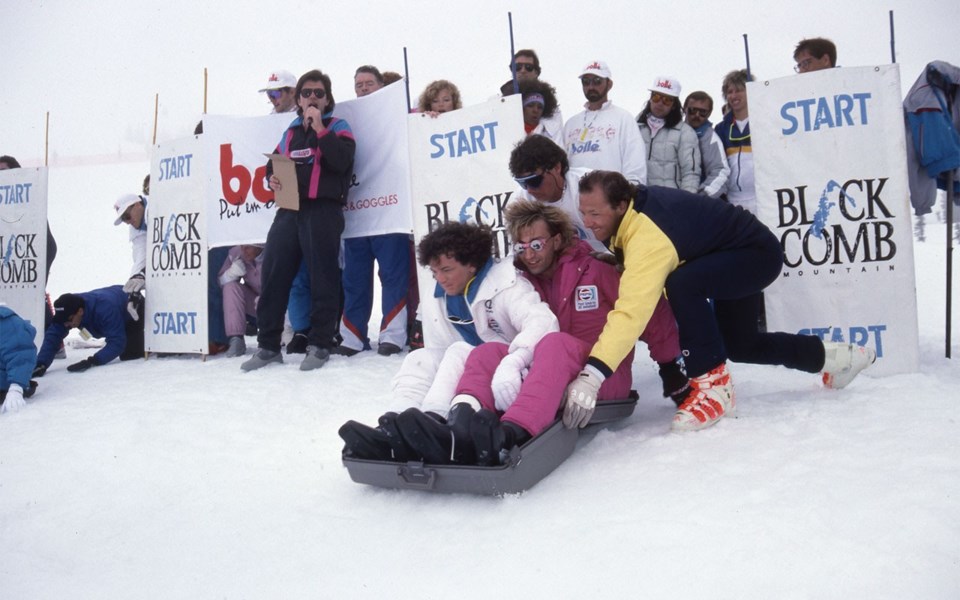We love newsletters at the museum.
They're a great way of keeping interested parties up to date and sharing information and, when donated to the archives, are a great record of changes to an organization over time. Recently, some of the museum's resource binders were digitized to make them text-searchable to help with our own and others' research projects. One of these binders housed a collection of newsletters published by Blackcomb Mountain over the late 1980s and early 1990s: the Blabcomb.
When the first edition of the Blabcomb came out on March 17, 1988 the newsletter was only four pages of news and updates related to Blackcomb operations; the last issue that the museum has a copy of, from July 12, 1991, had grown to 12.
Early issues of Blabcomb came out with payroll every two weeks, then switched to monthly publication for the summer months.
The issues included lists of birthdays, staff changes, discounts, meetings and recognition of the latest ICE (Inspire Continued Excellence) Awards. Even birth announcements made it in.
Though the newsletter included frequent calls for volunteers and contributions, it would seem Blabcomb was spearheaded by Eric Sinclair of Blackcomb's accounting department. The name "Blabcomb" was the product of Wayne "Chookhead" Burt, who won out against competing submissions such as "Snow News" (Bart Parsons), "Seventh Heaven Express" (Peter Bacholtz), and "Blackcomb Briefs" (Gerhard Reimer).
Considering the chatty (and, at times, perhaps gossipy) tone of the newsletter, Blabcomb seems like a perfect fit.
In some ways the resort described in the Blabcomb is very different from the Whistler Blackcomb operations of today. Some events, like the Celebrity Challenge Suitcase Race, no longer run and with the merger between Whistler and Blackcomb guest numbers are no longer a competition. Some parts of their spring 1988 newsletters, however, could almost be published today.
The Blabcomb reportedly began "in order to maintain the Blackcomb spirit," which some feared was being lost as the company grew (a feeling not unknown in Whistler).
In early March 1988 the Blackcomb staff (combining both employees of Blackcomb Skiing Enterprises and of Alta Lake Foods, which ran the food and beverage operations on the mountain) surpassed the 600 employees mark. The creation of the Blabcomb recognized that it could be "difficult to maintain that feeling of 'family' among such a large employee base."
With expanded food service and five new lifts added in 1987 (Magic Chair, Wizard Express, Solar Coaster Express, 7th Heaven Express and Horstman Glacier T-Bar) the 1987/88 season was a big year for Blackcomb Mountain. By early April it had exceeded 512,000 visits (to put the number in perspective, the previous record of 508,000 had been set by Whistler Mountain in the 1984/85 season) and looked on track to exceed 600,000 by the time the season ended.
Employees asked by the Blabcomb described the season as "exciting, exhausting, wild and, of course, magical" but the newsletter also acknowledged the toll the season had taken.
As they put it, "Not only did Blackcomb employees have to adjust to a massive expansion project that included new lifts, buildings and added responsibilities, they were overwhelmed by the number of skiers we received in Whistler Resort this year... A shortage of employees, cramped, and sometimes marginal living conditions made these 'adjustments' even more difficult."
Over the next few years the Blabcomb continued to update employees about changes in operations and events on the mountain, while also covering topics that we still discuss in Whistler today, such as the construction of employee housing (it was during this period that Blackcomb and CP Hotels, later the Chateau, built some of the housing currently in use).
Though newsletters are often written thinking of the present and future, they can be really useful resources when examining our past.




